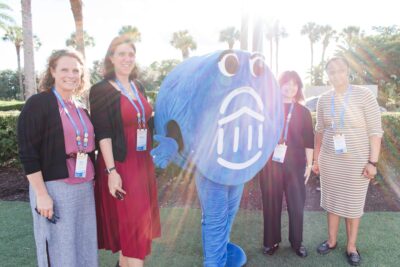How can a smartphone help improve student success?
When was the last time you were in an academic advising office? Any college administrator interested in student success should try spending some time with advisors during course registration. I say “try” because you very well might not be able to get in the door, blocked by the throngs of students trying to grab 15 or 30 minutes with an advisor to map out the best classes to take next term or choose the major that they will pursue for the next few years.
Conditions at many schools often aren’t much better during the “lull” periods in between registrations. Advisors have become the front-lines of the War on Attrition, and as such are called on to address any number of student concerns. In years past the advising profession has been largely about guiding student in choosing classes and majors. Now advisors are also asked to follow up on early alerts, proactively connect students to tutoring, provide career advice, and alleviate financial distress, among other activities that support students in their pursuit of a degree. At many schools, the academic advising staff are being stretched to the breaking point.
We continue to develop tools to help advisors extend their efforts to reach more students, but at some point universities will need to turn attention to helping students help themselves. This is one of the principles behind our Population Health Management framework. Borrowing a page from a similar concept in health care, we advocate for freeing up advisor capacity by deploying scalable student self-service to help lower-risk students handle many issues on their own though guided decision making. By doing so, we can prevent many problems before they occur while allowing advisors to rebalance their time toward higher-risk cases that need them the most.

We say “self-service” instead of “self-advising” because this is really all about providing students with tools and prompts to make good, informed decisions, rather than simply leaving them to fend for themselves.
Some schools have already made investments here. In our research we have uncovered several promising ideas from our members:
Unified student portals
In order for students to help themselves, they first need to know where to go to find information. Unfortunately, the websites for university support services can be just as disconnected as their brick-and-mortar counterparts.
The University of Minnesota is working to unify separate support organizations under a comprehensive student web portal. The portal places everything students need to know at their fingertips, including upcoming deadlines, course registration, grades and transcripts, financial aid and health care.
Through the portal, students can access and complete almost every possible administrative transaction on campus, all in one place. By pulling all these services together, Minnesota makes it much more likely that a student will be able to find and perform the online service that they need.
Personalized status alerts
Curating information in a single portal is a great first step, but even the best portals still assume that students knows what needs to be done when it needs to be done. We know all too well that messages prompting action often get lost and buried in students’ email inboxes. This means that support staff and faculty must send email after duplicative email in hopes of grabbing students’ attention.
Northern Arizona University’s personalized alerts dashboard bypasses inbox white noise so students recognize and resolve important issues and tasks. NAU embeds alerts on the homepage of their student information system (SIS), prompting students who log in with concise information related to their enrollment status, academic standing, degree progress, and attendance history—anything that clearly impacts retention and completion. The SIS displays each alert notification prominently, and provides simple action steps and clear links to resources for resolution. Automated alerts prove to be hard to ignore—more than 98.5% of students see the alerts—and resolve issues quickly while lowering the communications burden on university personnel. Since 2011, students have taken more than 171,000 actions prompted by follow-up steps listed with the alerts.
Data-driven interventions
Customization is another way to break through the noise and motivate a student to act. The University of Kentucky has already received a great deal of recognition for its mobile app myUK, which centralizes personalized, curated messages in a single platform. Beyond its mobile modality, however, the University of Kentucky employs a formidable high-speed, central analytics platform that performs sophisticated segmentation.
Instead of sending out blanket emails in hopes of prompting action, retention specialists can target precise messages to subgroups of students prescribing specific actions. For example, administrators can send students who received a C or lower on a STEM midterm but who never visited the tutoring center a message that says, “Struggling in science class? Check out our STEM tutoring service.” The analytics that power myUK ensure that each message is relevant, increasing the likelihood of response while reducing the burden on student support staff. With UK reporting 15,000 active users, the approach seems to be highly effective.
What comes next?
There are three big takeaways on “self-service” that I would want our members to get from these case studies:
- We need to make more information available to students and make it easier to access.
- We need to proactively prompt students when it is time to engage with these resources.
- Whenever possible, we need to customize the message to deliver guidance that is tailored to each student’s specific needs.
The customization and mobility of the myUK app gives us a glimpse of where “self-service” is heading. Most schools we speak with have invested in some kind of mobile platform. However, much like how the first motion pictures were just films of plays, most university apps are essentially just mobile versions of the university website. There’s so much more that can be done with a medium that can provide around-the-clock guidance while adapting to each individual user. This is the promise of adaptive self-service technologies.

More Blogs

Four signs it’s time to break up with your student CRM

Three lessons from 1,200 student success leaders on higher ed’s future
